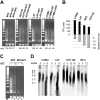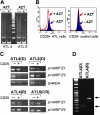Persistent inhibition of telomerase reprograms adult T-cell leukemia to p53-dependent senescence
- PMID: 16569765
- PMCID: PMC1895862
- DOI: 10.1182/blood-2006-01-0067
Persistent inhibition of telomerase reprograms adult T-cell leukemia to p53-dependent senescence
Abstract
The antiviral thymidine analog azidothymidine (AZT) is used to treat several virus-associated human cancers. However, to date the mechanism of AZT action remains unclear and thus, reasons for treatment failure are unknown. Adult T-cell leukemia/lymphoma (ATL) is an aggressive malignancy of poor prognosis. Here, we report that enduring AZT treatment of T-cell leukemia virus I-infected cells, in vitro and in vivo in ATL patients, results in inhibition of telomerase activity, progressive telomere shortening, and increased p14(ARF) expression. In turn, this elicits stabilization and reactivation of the tumor suppressor p53-dependent transcription, increased expression of the cyclin-dependent kinase inhibitor p21(Waf1), and accumulation of p27(kip1), thereby inducing cellular senescence and tumor cell death. While ATL patients carrying a wild-type p53 enter remission following treatment with AZT, those with a mutated p53 did not respond, and patients' disease relapse was associated with the selection of a tumor clone carrying mutated inactive p53.
Figures







Similar articles
-
Activation of p53 by Nutlin-3a, an antagonist of MDM2, induces apoptosis and cellular senescence in adult T-cell leukemia cells.Leukemia. 2009 Nov;23(11):2090-101. doi: 10.1038/leu.2009.171. Epub 2009 Aug 27. Leukemia. 2009. PMID: 19710698
-
Azidothymidine and cisplatin increase p14ARF expression in OVCAR-3 ovarian cancer cell line.Toxicol Appl Pharmacol. 2006 Oct 1;216(1):89-97. doi: 10.1016/j.taap.2006.04.015. Epub 2006 May 19. Toxicol Appl Pharmacol. 2006. PMID: 16797627
-
Arsenic trioxide and the growth of human T-cell leukemia virus type I infected T-cell lines.Leuk Lymphoma. 2000 May;37(5-6):649-55. doi: 10.3109/10428190009058521. Leuk Lymphoma. 2000. PMID: 11042529
-
Tumor suppressors and oncogenes in cellular senescence.Exp Gerontol. 2000 May;35(3):317-29. doi: 10.1016/s0531-5565(00)00083-8. Exp Gerontol. 2000. PMID: 10832053 Review.
-
Replicative senescence as a barrier to human cancer.Biochem Soc Trans. 2000 Feb;28(2):226-33. doi: 10.1042/bst0280226. Biochem Soc Trans. 2000. PMID: 10816133 Review.
Cited by
-
Impact of host immunity on HTLV-1 pathogenesis: potential of Tax-targeted immunotherapy against ATL.Retrovirology. 2019 Aug 22;16(1):23. doi: 10.1186/s12977-019-0484-z. Retrovirology. 2019. PMID: 31438973 Free PMC article. Review.
-
Current State of Therapeutics for HTLV-1.Viruses. 2024 Oct 15;16(10):1616. doi: 10.3390/v16101616. Viruses. 2024. PMID: 39459949 Free PMC article. Review.
-
Striving to cure adult T-cell leukaemia/lymphoma: a role for allogeneic stem cell transplant?Bone Marrow Transplant. 2016 Dec;51(12):1549-1555. doi: 10.1038/bmt.2016.154. Epub 2016 Sep 12. Bone Marrow Transplant. 2016. PMID: 27618683 Review.
-
AZT as a telomerase inhibitor.Front Oncol. 2012 Sep 6;2:113. doi: 10.3389/fonc.2012.00113. eCollection 2012. Front Oncol. 2012. PMID: 22973556 Free PMC article.
-
Emodin and DHA potently increase arsenic trioxide interferon-alpha-induced cell death of HTLV-I-transformed cells by generation of reactive oxygen species and inhibition of Akt and AP-1.Blood. 2007 Feb 15;109(4):1653-9. doi: 10.1182/blood-2006-04-015537. Epub 2006 Oct 31. Blood. 2007. PMID: 17077332 Free PMC article.
References
-
- Yoshida M. Multiple viral strategies of HTLV-1 for dysregulation of cell growth control. Annu Rev Immunol. 2001;19: 475-496. - PubMed
-
- Bazarbachi A, Ghez D, Lepelletier Y, et al. New therapeutic approaches for adult T-cell leukaemia. Lancet Oncol. 2004;5: 664-672. - PubMed
-
- Hermine O, Bouscary D, Gessain A, et al. Brief report: treatment of adult T-cell leukemia-lymphoma with zidovudine and interferon alfa. N Engl J Med. 1995;332: 1749-1751. - PubMed
Publication types
MeSH terms
Substances
Grants and funding
LinkOut - more resources
Full Text Sources
Research Materials
Miscellaneous

